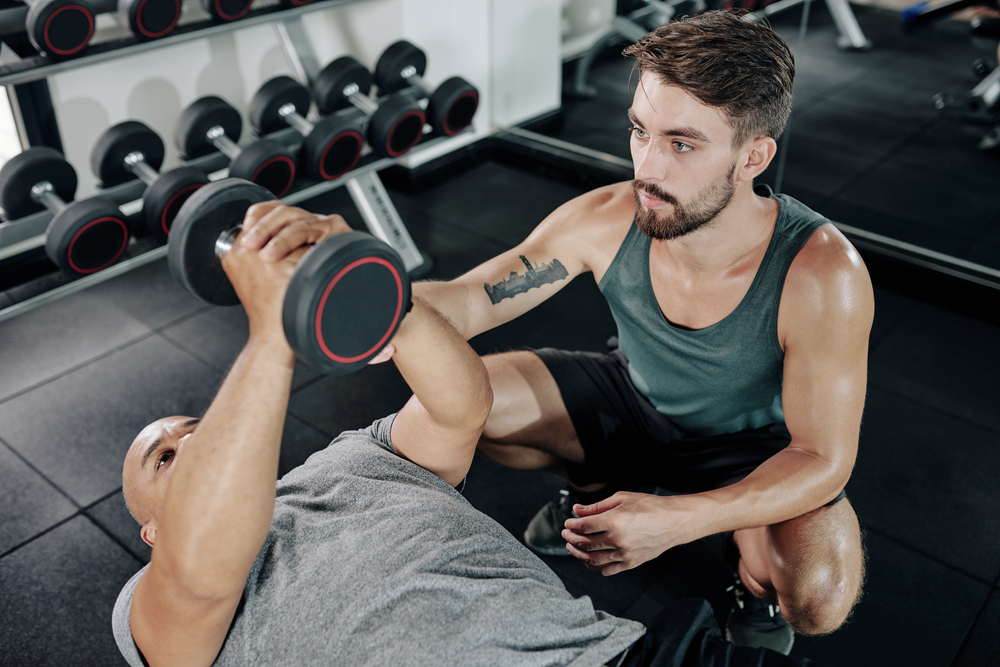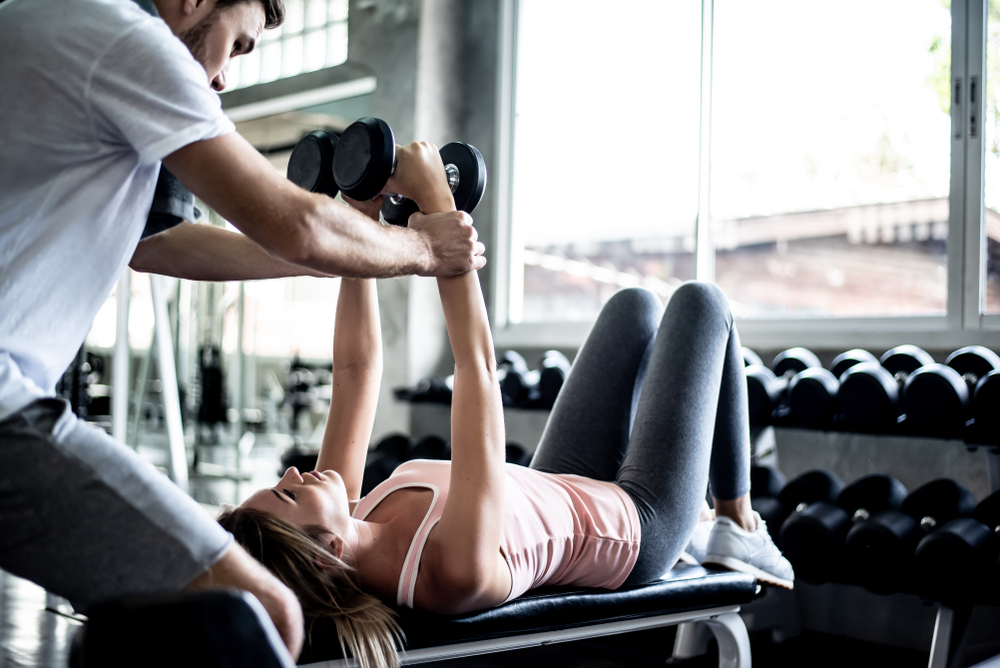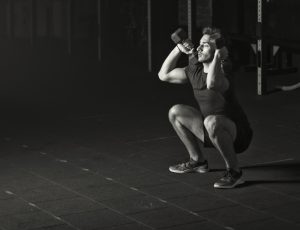The Tate Press is a unique triceps exercise that involves lying on a bench, pressing dumbbells overhead with palms facing forward, then lowering them to your chest while keeping your elbows flared outward and the dumbbells touching throughout the movement.
This elbow-friendly alternative to skull crushers specifically targets the medial and long heads of your triceps while mimicking the bench press movement pattern for better lockout strength.
Keep reading for the complete step-by-step technique, programming guidelines, and safety considerations that will help you master this powerful triceps builder.
What Makes the Tate Press Different from Other Triceps Exercises
Elite powerlifter Dave Tate developed this exercise in the 1990s specifically to boost his bench press performance while reducing the elbow pain he experienced from traditional triceps work.
The Tate Press addresses a common problem many lifters face – wanting to build stronger triceps without aggravating their joints.
What sets this movement apart is the unique elbow positioning.
Instead of pointing your elbows down toward the floor like you would during skull crushers, you flare them outward to the sides in what some coaches call a “chicken dance” position.
This adjustment completely changes how the exercise targets your triceps and significantly reduces stress on your elbow joints.
The movement specifically hits the medial and long heads of your triceps brachii from an uncommon angle that most other exercises miss.
Traditional triceps movements like close-grip bench press or overhead extensions don't provide this same targeting, which means you might have underdeveloped areas in your triceps that the Tate Press can address.
You'll also notice that the Tate Press mimics the exact movement pattern of the bench press more closely than other triceps exercises.
This makes it particularly valuable for powerlifters and anyone looking to improve their pressing strength, since the carryover is much more direct than what you'd get from isolation movements like triceps pushdowns.
For lifters dealing with elbow issues, this exercise offers a joint-friendly alternative that still delivers serious muscle-building results.
The outward elbow position and controlled movement pattern create less stress on your tendons while still providing the isolation work your triceps need to grow.
Step-by-Step Setup and Execution Technique
Follow these steps carefully to perform the Tate Press with proper form and maximum effectiveness.
Initial Setup:
- Lie flat on the bench with your back, head, shoulders, and butt maintaining full contact throughout the entire movement
- Plant your feet firmly on the floor directly underneath your knees for a stable base
- Select your dumbbells and position them close to your chest before lying back on the bench
Starting Position:
4. Press the dumbbells to full lockout overhead using a pronated grip with your palms facing forward
5. Position your thumbs so they point toward each other with the inner sides of the dumbbells touching
6. Keep your elbows pointed outward and ensure the dumbbells sit directly above your chest
The Descent Phase:
7. Flex at your elbows and lower the inner portions of the dumbbells toward your chest
8. Keep the dumbbells in contact with each other throughout the entire downward movement
9. Maintain your elbows flared outward – they should not point down like they would in skull crushers
10. Keep your upper arms stationary as you lower the weight
Bottom Position:
11. Continue lowering until the dumbbells touch your chest and your elbows form approximately a 90-degree angle
12. Pause briefly at the bottom position to maintain control
The Ascent Phase:
13. Press the dumbbells back to the starting position by extending your elbows
14. Focus on engaging your triceps and squeeze them hard at the top of the movement
15. Use the mental cue of pushing your pinkies upward toward the sky to maintain proper triceps activation throughout the lift
Critical Form Points That Make or Break Your Results
Getting the Tate Press right comes down to mastering several key technical elements that separate effective muscle building from wasted effort or potential injury.
Elbow Positioning is Everything
The most important aspect of this exercise is your elbow positioning – think “chicken dance” style with your elbows flared out to the sides.
This isn't just a quirky description; it's the fundamental difference between a Tate Press and other triceps movements.
You'll need to experiment with the exact degree of elbow flare to find what feels comfortable for your shoulders and elbows, as individual anatomy varies.
Control Your Tempo and Weight
Slow and controlled motions are non-negotiable for this exercise.
Follow the tempo guideline of taking twice as long to lower the dumbbells as you do to raise them.
This controlled descent maximizes muscle tension and reduces the risk of injury.
You should also maintain tension on your triceps throughout the entire movement by limiting your lockout at the top – avoid completely straightening your arms, which removes tension from the target muscles.
Build a Rock-Solid Foundation
Your body positioning creates the stable platform your triceps need to work effectively.
Brace your core, glutes, and lower back to ensure you have a solid base throughout the exercise.
Squeeze your shoulder blades together and maintain contact between your head, shoulders, and butt with the bench at all times.
Don't Neglect the Details
Wrist stability often gets overlooked but plays a major role in your success.
Grip the dumbbells firmly and keep your wrists in a neutral position – avoid letting them bend or collapse under the weight.
Most importantly, keep the dumbbells in contact with each other throughout the entire range of motion.
The moment they separate, you lose the unique benefits that make this exercise special.
Weight Selection and Programming for Maximum Growth

Choosing the right weight and programming approach can make the difference between steady triceps growth and spinning your wheels in the gym.
Start Light and Master the Movement
The Tate Press requires more coordination than typical triceps exercises, so you need to start with lighter weights to master the movement pattern first.
Focus on using a weight that allows you to perform smooth, controlled motion for at least 8-12 reps, which sits in the sweet spot for muscle growth.
Don't let your ego drive your weight selection – this exercise demands precision over pure load.
Hypertrophy-Focused Programming
For maximum muscle growth, you have two effective approaches.
The first option involves performing 3-5 sets of 8-15 reps using moderate to heavy weight while maintaining perfect form.
Alternatively, you can use 2-4 sets of 10-15 reps taken to failure, which can be particularly effective for pushing your triceps to grow.
Both approaches work well when you rest 45-90 seconds between sets, giving your muscles enough recovery without losing the training stimulus.
Strength-Building Applications
If your goal is building raw strength rather than size, focus on 2-5 sets of 5-10 reps using heavier weight.
Remember that strength work still requires perfect form – compromising technique for heavier weight defeats the purpose and increases injury risk.
Recovery and Blood Flow Work
You can also use the Tate Press with lighter weights for higher rep ranges to drive blood flow to your elbows and surrounding tissues.
This approach works well on recovery days or as a finisher after your main triceps work.
Progressive Overload Strategy
Like any exercise, you need a plan for progression.
Increase weight gradually while maintaining perfect form, or add reps within your target range before jumping to heavier dumbbells.
The key is consistent progression without sacrificing the technical precision that makes this exercise effective.
Safety Guidelines and Common Mistakes to Avoid
The Tate Press can be incredibly effective when performed correctly, but several common errors can derail your progress or lead to injury.
Primary Safety Priorities
Your wrists take on significant stress during this movement, so maintaining wrist stability through a firm grip and neutral positioning is non-negotiable.
Avoid letting your wrists bend or collapse under the weight, as this transfers stress to smaller joints that aren't designed to handle heavy loads.
Gradual weight progression is equally important – rushing to add weight before you've mastered the movement pattern often leads to muscle strain and injury.
The Most Common Form Mistakes
Using excessive weight ranks as the top mistake you can make with this exercise.
When you load too much weight, your form breaks down and you end up placing more strain on your tendons and elbows rather than effectively targeting your triceps for growth.
Another frequent error involves wrong elbow positioning – specifically, positioning your elbows like you would during skull crushers with them pointing down instead of flaring them out to the sides.
This completely changes the exercise and eliminates the benefits that make the Tate Press unique.
Many lifters also allow their dumbbells to move apart during the movement instead of keeping them in contact throughout.
When the dumbbells separate, you lose the specific muscle activation pattern that makes this exercise so effective.
Range of Motion and Movement Quality
Don't restrict your range of motion by failing to bring the dumbbells all the way to your chest or not extending your arms fully at the top.
Both of these shortcuts reduce the exercise's effectiveness and limit your triceps development.
Injury Prevention and Pain Management
Proper warm-up protocols are essential since your elbows are prone to tendonitis and pain.
If you experience discomfort during the exercise, first reduce the weight and check your form carefully.
For those who continue experiencing issues despite proper technique, resistance bands offer an alternative option that provides similar benefits with less joint stress.
If pain persists even after making these adjustments, it's best to avoid this exercise entirely and focus on other triceps movements.
Exercise Variations and Programming Integration
The Tate Press offers several variations and strategic programming options that can enhance your training results and address specific needs.
Effective Variations to Try
The incline Tate Press performed on an incline bench increases the stretch on your triceps and targets the muscle from a different angle, providing a greater range of motion than the flat bench version.
This variation can be particularly effective for those looking to maximize muscle development through increased stretch under load.
You can also perform a single-arm variation to identify and correct muscle imbalances between your left and right sides.
This unilateral approach forces each arm to work independently and can reveal strength discrepancies you might not notice during bilateral movements.
For individuals who are joint-sensitive or experience discomfort with traditional weights, the resistance band version offers similar benefits with reduced stress on your elbows and surrounding connective tissues.
Smart Programming Integration
The Tate Press works best when integrated after your main strength training work, typically at the end of pressing sessions or during your accessory work.
This timing allows you to focus on heavy compound movements first when you're fresh, then use the Tate Press to target your triceps specifically for additional growth stimulus.
Who Should Use This Exercise
This exercise is generally recommended for experienced lifters who already have a solid strength base, as it requires high levels of triceps strength and shoulder stability to perform safely and effectively.
Beginners might struggle with the coordination demands and should master basic triceps movements first.
Performance Benefits Beyond Muscle Growth
The Tate Press offers significant benefits for your bench press lockout strength and overall pressing performance due to its movement pattern similarity.
Regular practice can improve your ability to lock out heavy bench presses, making it particularly valuable for powerlifters and strength athletes.
Additionally, the controlled movement pattern and increased blood flow to the elbow area can improve elbow health and potentially help prevent injuries commonly associated with heavy pressing work.
Conclusion
The Tate Press stands out as a superior triceps exercise that combines muscle-building effectiveness with joint-friendly mechanics, making it an excellent choice for lifters seeking both growth and longevity.
Master the unique elbow-flared technique with lighter weights first, then gradually progress while maintaining strict form to maximize your results.
Integrate this exercise into your pressing sessions as accessory work, and you'll likely see improvements in both triceps development and bench press lockout strength.







